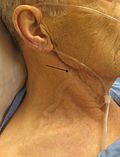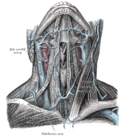Jugular venous pressure
The Jugular Venous Pressure (JVP), occasionally referred to as the jugular venous pulse, represents an indirect evaluation of the pressure within the right atrium of the heart. Clinicians observe this pressure by inspecting the internal jugular vein, and it serves as a critical diagnostic tool for differentiating various types of heart and lung diseases.
Physiological Basis[edit]
The JVP arises from blood flowing back into the venous system, reflecting the pressure dynamics within the right atrium. It comprises of three upward (a, c, and v waves) and two downward deflections (x and y descents), each corresponding to specific physiological events within the cardiac cycle.
Clinical Assessment[edit]
JVP assessment is a standard part of the cardiovascular examination, providing information on fluid balance, right heart function, and central venous pressure. Clinicians usually measure it with the patient positioned at a 45-degree angle, identifying the highest point of oscillation of the internal jugular vein.
Pathophysiology and Clinical Significance[edit]
Alterations in JVP can indicate various pathophysiological conditions. Elevated JVP, for instance, may suggest right ventricular failure, tricuspid valve disease, or pulmonary hypertension. In contrast, a decreased JVP may indicate hypovolemia.
The specific wave patterns can also help identify heart conditions. For instance, a prominent 'a' wave might suggest tricuspid stenosis or right atrial myxoma, while large 'v' waves might indicate tricuspid regurgitation.
Limitations[edit]
While JVP is a valuable clinical indicator, it is not without limitations. Inter-observer variability, obesity, and patient positioning can affect its measurement accuracy.
References[edit]
<references/>
- 1. "Understanding jugular venous pressure." American Family Physician. [Link]
- 2. Colombo PC, Doran AC, Onat D, Wong F. (2020). "Clinical Assessment of the Jugular Venous Pressure." JACC Heart Fail. 8(12):1049-1051.
- 3. Cook DJ, Simel DL. (1996). "The Rational Clinical Examination. Does this patient have abnormal central venous pressure?" JAMA. 275(8):630-4.
- 4. Sarkisian AE. (2006). "Use of the physical examination to assess for volume status in heart failure patients." Curr Heart Fail Rep. 3(2):65-70.
|
|
|
| Medical examination and history taking | ||||||||||||||||||
|---|---|---|---|---|---|---|---|---|---|---|---|---|---|---|---|---|---|---|
|
| Physiology of the cardiovascular system | ||||||||||||||
|---|---|---|---|---|---|---|---|---|---|---|---|---|---|---|
|
| Symptoms and signs relating to the cardiovascular system | ||||||||||
|---|---|---|---|---|---|---|---|---|---|---|
|
Jugular_venous_pressure[edit]
-
Elevated jugular venous pressure
-
Anatomy of the jugular vein
-
Jugular venous pressure waveform
Ad. Transform your life with W8MD's Budget GLP-1 injections from $75


W8MD offers a medical weight loss program to lose weight in Philadelphia. Our physician-supervised medical weight loss provides:
- Weight loss injections in NYC (generic and brand names):
- Zepbound / Mounjaro, Wegovy / Ozempic, Saxenda
- Most insurances accepted or discounted self-pay rates. We will obtain insurance prior authorizations if needed.
- Generic GLP1 weight loss injections from $75 for the starting dose.
- Also offer prescription weight loss medications including Phentermine, Qsymia, Diethylpropion, Contrave etc.
NYC weight loss doctor appointmentsNYC weight loss doctor appointments
Start your NYC weight loss journey today at our NYC medical weight loss and Philadelphia medical weight loss clinics.
- Call 718-946-5500 to lose weight in NYC or for medical weight loss in Philadelphia 215-676-2334.
- Tags:NYC medical weight loss, Philadelphia lose weight Zepbound NYC, Budget GLP1 weight loss injections, Wegovy Philadelphia, Wegovy NYC, Philadelphia medical weight loss, Brookly weight loss and Wegovy NYC
|
WikiMD's Wellness Encyclopedia |
| Let Food Be Thy Medicine Medicine Thy Food - Hippocrates |
Medical Disclaimer: WikiMD is not a substitute for professional medical advice. The information on WikiMD is provided as an information resource only, may be incorrect, outdated or misleading, and is not to be used or relied on for any diagnostic or treatment purposes. Please consult your health care provider before making any healthcare decisions or for guidance about a specific medical condition. WikiMD expressly disclaims responsibility, and shall have no liability, for any damages, loss, injury, or liability whatsoever suffered as a result of your reliance on the information contained in this site. By visiting this site you agree to the foregoing terms and conditions, which may from time to time be changed or supplemented by WikiMD. If you do not agree to the foregoing terms and conditions, you should not enter or use this site. See full disclaimer.
Credits:Most images are courtesy of Wikimedia commons, and templates, categories Wikipedia, licensed under CC BY SA or similar.
Translate this page: - East Asian
中文,
日本,
한국어,
South Asian
हिन्दी,
தமிழ்,
తెలుగు,
Urdu,
ಕನ್ನಡ,
Southeast Asian
Indonesian,
Vietnamese,
Thai,
မြန်မာဘာသာ,
বাংলা
European
español,
Deutsch,
français,
Greek,
português do Brasil,
polski,
română,
русский,
Nederlands,
norsk,
svenska,
suomi,
Italian
Middle Eastern & African
عربى,
Turkish,
Persian,
Hebrew,
Afrikaans,
isiZulu,
Kiswahili,
Other
Bulgarian,
Hungarian,
Czech,
Swedish,
മലയാളം,
मराठी,
ਪੰਜਾਬੀ,
ગુજરાતી,
Portuguese,
Ukrainian





